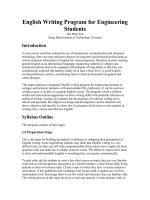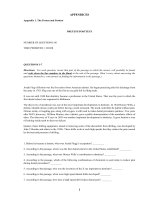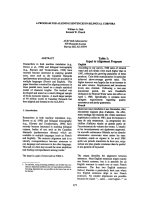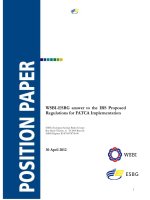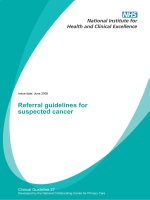IRS referral program for suspected tax fraud
Bạn đang xem bản rút gọn của tài liệu. Xem và tải ngay bản đầy đủ của tài liệu tại đây (5.81 MB, 84 trang )
GOVERNMENT PROCEDURES AND OPERATIONS
IRS REFERRAL PROGRAM
FOR SUSPECTED TAX FRAUD
ISSUES AND ASSESSMENTS
No part of this digital document may be reproduced, stored in a retrieval system or transmitted in any form or
by any means. The publisher has taken reasonable care in the preparation of this digital document, but makes no
expressed or implied warranty of any kind and assumes no responsibility for any errors or omissions. No
liability is assumed for incidental or consequential damages in connection with or arising out of information
contained herein. This digital document is sold with the clear understanding that the publisher is not engaged in
rendering legal, medical or any other professional services.
GOVERNMENT PROCEDURES
AND OPERATIONS
Additional books in this series can be found on Nova’s website
under the Series tab.
Additional e-books in this series can be found on Nova’s website
under the eBooks tab.
GOVERNMENT PROCEDURES AND OPERATIONS
IRS REFERRAL PROGRAM
FOR SUSPECTED TAX FRAUD
ISSUES AND ASSESSMENTS
KEITH WATKINS
EDITOR
New York
Copyright © 2016 by Nova Science Publishers, Inc.
All rights reserved. No part of this book may be reproduced, stored in a retrieval system or transmitted
in any form or by any means: electronic, electrostatic, magnetic, tape, mechanical photocopying,
recording or otherwise without the written permission of the Publisher.
We have partnered with Copyright Clearance Center to make it easy for you to obtain permissions to
reuse content from this publication. Simply navigate to this publication’s page on Nova’s website and
locate the “Get Permission” button below the title description. This button is linked directly to the title’s
permission page on copyright.com. Alternatively, you can visit copyright.com and search by title, ISBN,
or ISSN.
For further questions about using the service on copyright.com, please contact:
Copyright Clearance Center
Phone: +1-(978) 750-8400
Fax: +1-(978) 750-4470
E-mail:
NOTICE TO THE READER
The Publisher has taken reasonable care in the preparation of this book, but makes no expressed or
implied warranty of any kind and assumes no responsibility for any errors or omissions. No liability is
assumed for incidental or consequential damages in connection with or arising out of information
contained in this book. The Publisher shall not be liable for any special, consequential, or exemplary
damages resulting, in whole or in part, from the readers’ use of, or reliance upon, this material. Any parts
of this book based on government reports are so indicated and copyright is claimed for those parts to the
extent applicable to compilations of such works.
Independent verification should be sought for any data, advice or recommendations contained in this
book. In addition, no responsibility is assumed by the publisher for any injury and/or damage to persons
or property arising from any methods, products, instructions, ideas or otherwise contained in this
publication.
This publication is designed to provide accurate and authoritative information with regard to the subject
matter covered herein. It is sold with the clear understanding that the Publisher is not engaged in
rendering legal or any other professional services. If legal or any other expert assistance is required, the
services of a competent person should be sought. FROM A DECLARATION OF PARTICIPANTS
JOINTLY ADOPTED BY A COMMITTEE OF THE AMERICAN BAR ASSOCIATION AND A
COMMITTEE OF PUBLISHERS.
Additional color graphics may be available in the e-book version of this book.
Library of Congress Cataloging-in-Publication Data
ISBN: 978-1-53610-372-4 (eBook)
Published by Nova Science Publishers, Inc. † New York
CONTENTS
Preface
Chapter 1
Chapter 2
Index
vii
IRS Referral Programs: Opportunities Exist
to Strengthen Controls and Increase
Coordination across Overlapping Programs
United States Government
Accountability Office
1
Taxpayer Referrals of Suspected Tax Fraud
Result in Tax Assessments, but Processing
of the Referrals Could Be Improved
Treasury Inspector General
for Tax Administration
47
71
PREFACE
Reports by the public of suspected underreporting of taxes or other tax
violations can help IRS detect millions of dollars in taxes that would otherwise
go uncollected. Productive referrals can help address the net $385 billion tax
gap—the difference between the amount of taxes paid voluntarily on time and
the amount owed. IRS received about 87,000 information referrals in fiscal year
2015. This book describes IRS’s process for screening and routing information
referrals; assesses the controls for the information referral screening and routing
process; and evaluates the coordination between the information referral
process, the Whistleblower Office, and other IRS referral programs.
In: IRS Referral Program for Suspected Tax Fraud ISBN: 978-1-53610-371-7
Editor: Keith Watkins
© 2016 Nova Science Publishers, Inc.
Chapter 1
IRS REFERRAL PROGRAMS:
OPPORTUNITIES EXIST TO STRENGTHEN
CONTROLS AND INCREASE COORDINATION
ACROSS OVERLAPPING PROGRAMS
United States Government Accountability Office
ABBREVIATIONS
CI
EITC
ICT
IDRS
IRM
IRS
SB/SE
TE/GE
TIGTA
TIN
W&I
Criminal Investigation Division
Earned Income Tax Credit
Image Control Team
Integrated Data Retrieval System
Internal Revenue Manual
Internal Revenue Service
Small Business/Self-Employed Division
Tax Exempt and Government Entities Division
Treasury Inspector General for Tax Administration
Taxpayer Identification Number
Wage and Investment Division
This is an edited, reformatted and augmented version of The United States Government
Accountability Office publication, Report to Congressional Requesters GAO-11-117, dated
January 2011.
2
United States Government Accountability Office
WHY GAO DID THIS STUDY
Reports by the public of suspected underreporting of taxes or other tax
violations can help IRS detect millions of dollars in taxes that would otherwise
go uncollected. Productive referrals can help address the net $385 billion tax
gap—the difference between the amount of taxes paid voluntarily on time and
the amount owed. IRS received about 87,000 information referrals in fiscal year
2015.
GAO was asked to assess the overall effectiveness of the information
referral process. This report (1) describes IRS’s process for screening and
routing information referrals; (2) assesses the controls for the information
referral screening and routing process; and (3) evaluates the coordination
between the information referral process, the Whistleblower Office, and other
IRS referral programs. GAO reviewed IRS guidance, processes, and controls
for the information referral process, assessed whether IRS’s processes followed
Standards for Internal Control in the Federal Government, and interviewed
IRS officials.
WHAT GAO RECOMMENDS
GAO recommends, among other things, that IRS establish an organizational
structure that identifies responsibility for defining objectives and for measuring
results for information referrals; document procedures for the information
referral process; and establish a coordination mechanism across IRS referral
programs. IRS agreed with GAO’s recommendations.
WHAT GAO FOUND
Information referrals from the public alleging tax noncompliance must be
submitted on paper forms by mail to the Internal Revenue Service (IRS). These
referrals are manually screened by clerical staff and routed by mail to units
across IRS for further action.
Ineffective internal controls undercut IRS management of the information
referral process. IRS does not have an organizational structure for information
referrals with clear leadership for defining objectives and outcomes for
measuring cost-effectiveness and results. Without clear leadership, IRS does not
IRS Referral Programs
3
know how effectively it is leveraging information referrals to address the tax gap.
IRS has incomplete documentation of procedures for the information referral
process, increasing the risk of delays and added costs in routing the information
for further action. Although one-quarter of the information referrals in fiscal year
2015 were sent for destruction after screening, IRS has not documented
procedures for supervisory review of those referrals prior to destruction. Without
procedures to address these control deficiencies, IRS is compromised in its
ability to know how effectively it is leveraging tax noncompliance information
reported by the public.
Fragmentation and overlap across IRS’s general information referral
process and eight specialized referral programs, such as for reporting identity
theft and misconduct by return preparers, can confuse the public trying to
report tax noncompliance to IRS. Yet coordination between referral programs
is limited, and IRS does not have a mechanism for sharing information on
crosscutting issues and collaborating to improve the efficiency of operations
across the mix of referral programs. As a result, IRS may be missing
opportunities to leverage resources and reduce the burden on the public trying
to report possible noncompliance.
***
February 23, 2016
The Honorable Orrin Hatch
Chairman
The Honorable Ron Wyden
Ranking Member
Committee on Finance United States Senate
The Honorable Charles E. Grassley
Chairman
Committee on the Judiciary
United States Senate
The Honorable Peter Roskam Chairman
Subcommittee on Oversight Committee on Ways and Means
House of Representatives
4
United States Government Accountability Office
One of the ways the Internal Revenue Service (IRS) promotes voluntary
compliance is by collecting revenue from noncompliant taxpayers—giving
honest taxpayers confidence that others are paying their fair share. To do so,
IRS leverages external resources to identify tax revenue that would otherwise
go uncollected: these external resources include referrals from the public that
provide information about suspected tax noncompliance by individuals and
businesses, as well as by government and tax-exempt entities. Proceeds from
productive referrals can help reduce the tax gap—the estimated difference
between the taxes paid voluntarily on time and what taxpayers actually owe.1
IRS estimated that for tax year 2006, the $450 billion gross tax gap included
$376 billion in underreporting on tax returns, $46 billion due in delinquent tax
debt, and $28 billion due in unfiled tax returns. IRS estimates that it will
eventually recover about 14 percent ($65 billion) of the gross tax gap through
late payments and enforcement actions, including collection.
Individuals can report alleged tax noncompliance by individuals and
businesses to IRS using IRS’s Information Referral (Form 3949-A), which
covers underreporting of income, false claims of tax benefits, failure to file a
return, and failure to withhold and pay taxes. Individuals submitting an
information referral can report alleged tax noncompliance anonymously. Those
seeking a financial award instead are to file their claims using Form 211 with
the IRS Whistleblower Office. IRS also has other specialized referral programs
handling identity theft, misconduct by tax return preparers, or wrongdoing by
tax-exempt organizations.
During fiscal year 2015, IRS had over 1 million visits to its tax fraud
reporting web page which identifies several IRS referral forms available to
report alleged tax noncompliance. IRS received over 87,000 information
referrals. IRS faces the challenge of screening the volume of these information
referrals—which cover a range of tax issues—and of identifying those with
the greatest potential to help IRS collect tax revenue that would otherwise go
uncollected. Resource limitations and interest in minimizing taxpayer burden
result in IRS auditing a small fraction of the total number of tax returns filed
for a given tax year.2 Targeting audits to noncompliant returns reduces the
burden on compliant taxpayers.
The Treasury Inspector General for Tax Administration (TIGTA) has
previously reported on limitations with IRS handling of information referrals.
In September 2012, TIGTA found the instructions for Form 3949-A were
confusing and submission of incomplete referrals was not useful for IRS followup. About 3,000 identify theft reports incorrectly submitted on the information
referral form were destroyed by IRS due to a lack of procedures on how to
IRS Referral Programs
5
process these claims.3 In February 2013, TIGTA found that IRS units did not
have routine processes to screen referrals for audit follow-up.4 In response, IRS
took steps to revise the information referral form and its instructions and set up
an agency-wide coordination team to develop information referral screening
guidelines.
You asked us to assess the overall effectiveness of IRS’s information
referral process. This report (1) describes IRS’s process for screening and
routing information referrals and for prioritizing information referrals within the
IRS audit workload; (2) assesses the controls for the information referral
screening and routing process; and (3) evaluates the coordination between the
information referral process, the Whistleblower Office, and other IRS referral
programs.
For the first objective, we reviewed IRS documents describing the
information referral screening and routing process, including the Internal
Revenue Manual (IRM)5 and Form 3949-A Screening and Routing Guidelines
(the guidelines). We interviewed IRS officials responsible for maintaining the
guidelines and those overseeing the screening and routing process and in March
2015 we observed the information referral screening process in Fresno,
California. We analyzed data on the volume of information referrals received
and routed to operating divisions for fiscal years 2012 through 2015. Based on
our testing of the data and review of documentation and interviews, we
identified several discrepancies in the information referral inventory reporting
(described later in this report) but determined that the data were reliable for the
purposes of this report. We reviewed IRS policy and procedure documents that
describe the processes for screening, classifying, prioritizing, and selecting
Form 3949-A for audit. We also interviewed IRS audit officials responsible for
these processes in the Wage and Investment (W&I) and Small Business/SelfEmployed (SB/SE) divisions because they receive about two-thirds of the
referrals sent for review, and in the Criminal Investigation (CI) division, which
receives referrals involving possible large dollar value or broader schemes. In
addition, we analyzed data from the Audit Information Management System
on referral audits closed in fiscal years 2012 through 2015 and the
recommended tax assessments. Based on our testing of the data and review of
documentation and interviews, we determined that these data were reliable for
the purposes of this report.
For the second objective, we reviewed the existing internal controls for the
information referral screening process and assessed whether the procedures
adhered to relevant Standards for Internal Control in the Federal Government.6
To assess how IRS implements its procedures and controls, we used the
6
United States Government Accountability Office
guidelines and other procedure documents as criteria. We also reviewed
inventory data including data on misrouted referrals returned by other IRS units
for fiscal years 2012 through 2015, and we interviewed IRS officials on
misrouted referrals. Based on our review of the data and interviews, we
determined that the misroute data were not reliable for the purposes of this report
because the total number of misroutes is unknown as not all misrouted referrals
are properly identified and recorded. In addition, we reviewed a
nongeneralizable sample of 38 referrals—selected using a systematic sample
from among the 5,935 referrals retained for destruction from January through
March 2015—to check whether IRS followed its procedures.7 We also reviewed
12 referrals related to child identity theft out of 155 referrals that were retained
for destruction in March 2015—to follow-up on information obtained during
the site visit regarding Image Control Team (ICT) clerical staff screening of
referrals alleging child identity theft. Finally, we interviewed IRS officials about
the processes and controls for the guidelines and screening process and to
discuss any potential deficiencies we identified.
For the third objective, we reviewed referral programs with specialized
forms for reporting identity theft, fraud by tax return preparers, abusive tax
promotions, and misconduct by tax-exempt organizations. We analyzed and
compared IRS forms used in the referral programs to identify common
information items as well as information specific to each program. We also drew
on information and analysis from our October 2015 report on the IRS
Whistleblower Office.8 We reviewed the IRM and other IRS guidance and
interviewed IRS officials for each referral program to determine how the other
referral programs receive and screen their referrals. We assessed coordination
among IRS’s programs using the relevant Standards for Internal Control in the
Federal Government and our prior work on interagency collaboration that
identifies key practices and considerations for implementing collaborative
mechanisms.9 We also drew on our April 2015 guide on fragmentation, overlap,
and duplication.10
We conducted this performance audit from December 2014 to February
2016 in accordance with generally accepted government auditing standards.
Those standards require that we plan and perform the audit to obtain sufficient,
appropriate evidence to provide a reasonable basis for our findings and
conclusions based on our audit objectives. We believe that the evidence
obtained provides a reasonable basis for our findings and conclusions based on
our audit objectives. For more detailed information on our scope and
methodology, see appendix I.
IRS Referral Programs
7
BACKGROUND
Overview of IRS Referrals for Tax Noncompliance
In order to collect tax revenue that would otherwise go uncollected and
resolve threats to the integrity and fairness of the tax system, IRS encourages
the public to report possible federal tax noncompliance and fraud. IRS has a web
page to help the public find resources for reporting both general and specific
types of federal tax noncompliance.11 IRS’s information referral process is for
reporting general types of tax noncompliance, including failure to file a tax
return, report income, or pay taxes owed. IRS has other specialized processes
for reporting specific types of tax noncompliance, such as identity theft and
misconduct by a tax return preparer.
In fiscal year 2015, IRS received over 87,000 information referrals, as
shown in figure 1. During fiscal years 2013 and 2014, IRS revised the
information referral instructions for the public to help clarify the other specific
forms to use to report directly to IRS’s specialized referral programs, which IRS
officials said has contributed to the reduced volume in information referrals.
Source: GAO analysis of IRSdocuments. | GAO-16-155.
Figure 1. Total Form 3949-A Information Referrals Received By IRS, Fiscal Years
2012-2015.
8
United States Government Accountability Office
Paper Information Referrals Mailed to IRS
The public reports general tax noncompliance—by individuals, businesses,
or both—by submitting Form 3949-A. The form provides checkboxes for
identifying 16 types of noncompliance (including activities such as organized
crime, narcotics income, and false/altered documents) and requests the dollar
amounts and years of unreported income, among other things (see figure 2). The
form instructions, which are reproduced in appendix II, explain the different
checkboxes for reporting tax noncompliance.
Source: IRS. | GAO-16-155.
Figure 2. Excerpt from IRS Form 3949-A Information Referral.
In completing the information referral form, a person is asked to provide as
much information as possible identifying the name, address, and tax
identification number of the taxpayer reported. Providing partial information
does not mean IRS will reject the information outright, but insufficient
identifying information may preclude IRS from making use of a referral. The
person submitting an information referral is also asked to provide personal
identifying information but may submit anonymously. Persons submitting an
information referral are not entitled to any reward if the information is used and
results in additional tax being collected.12 Once the form is completed, the
person mails it to the IRS submission processing center in Fresno, California,
where the form enters the information referral process.13
IRS Referral Programs
9
IRS Roles and Responsibilities for Processing
Information Referrals
As summarized in table 1, multiple units across IRS play important roles in
processing information referrals submitted by the public:
The Image Control Team (ICT), within the submission processing
center in Fresno, California, receives and initially screens paper
information referrals received by mail for routing to other IRS units for
further action. Like other ICT clerical units, the Fresno ICT is also
responsible for processing, distributing, and managing other timesensitive taxpayer correspondence.14
Submission Processing management assigns Fresno ICT staff for
information referral screening as resources are available.15
Accounts Management maintains the guidelines and facilitates
coordination between Submission Processing, Fresno ICT, and the
various IRS units, such as SB/SE and W&I, which receive information
referrals for follow-up.
Tiger Team—established in October 2012 by IRS with membership
composed of representatives from Accounts Management, Submission
Processing, and IRS audit and investigation operating divisions—is
responsible for developing the guidelines for screening and routing
information referrals for further action. The Tiger Team meets bimonthly
to discuss the guidelines, provide feedback on information referrals
misrouted to other IRS units, and receive updates on the number of
information referrals received and screened and routed by Fresno ICT.
In addition, the Tiger Team receives questions from Fresno ICT
regarding how the information referrals should be handled when new
situations arise.
Following initial processing, IRS operating divisions screen information
referrals for audit and investigation potential. The W&I division handles
referrals about individual income taxpayers. The SB/SE division handles
referrals about small businesses and business income for individual taxpayers.
The Large Business and International division handles referrals about large
corporations and partnerships as well as international income tax issues. The
Tax Exempt and Government Entities (TE/GE) division receives referrals about
tax-exempt organizations, employee retirement plans, and government entities.
10
United States Government Accountability Office
The Criminal Investigation (CI) division receives referrals about schemes and
transactions involving larger dollars or numbers of taxpayers.
Table 1. Overview of Responsibilities for Information
Referral Processing Across IRS
IRS unit
Responsibilities
Fresno Image Screens and routes information referrals submitted by the public
Control Team using the Form 3949-A
(ICT)
Screening and Routing Guidelines (the guidelines).
Reports weekly to Accounts Management on inventory of
information referrals received and screening and routing activity.
Participates in monthly coordination meetings between
Submission Processing and Accounts Management.
Participates in bimonthly meetings for the Tiger team.
Submission
Assigns staffing for information referral screening and routing.
Processing
Supervises the Image Control Team clerical unit.
Participates in monthly coordination meetings between
Submission Processing and Accounts Management.
Participates in bimonthly meetings for the Tiger team.
Accounts
Maintains and updates the guidelines.
Management Provides oversight for information referral inventory reports.
Leads the monthly coordination meetings between Submission
Processing and Accounts Management.
Leads the bimonthly meetings for the Tiger team.
Tiger Team
Develops the specific guidelines for screening and routing
information referrals to IRS units for further action.
Meets bimonthly to discuss emerging issues and consider changes
to the guidelines.
Tiger team membership includes representatives from Accounts
Management, Submission Processing, and IRS audit and
investigation operating divisions.
Source: GAO analysis of IRS documents and interviews with IRS officials. | GAO-16155.
IRS Referral Programs
11
INFORMATION REFERRAL SCREENING IS A MANUAL
PROCESS, AND OPERATING DIVISION PRIORITIES
DETERMINE AUDIT SELECTION
The information referral screening and routing process involves multiple
steps, as shown in figure 3. The process begins when a person mails a paper
information referral reporting alleged tax noncompliance to IRS in Fresno,
California. The process ends with the information referral being retained for
destruction or routed by mail to an operating division or other IRS unit for
additional review to determine if the alleged wrongdoer may owe taxes or face
other enforcement actions.
Source: GAO analysis of IRS information. | GAO-16-155.
Figure 3. Process for Screening and Routing Information Referrals for Further Review.
Intake. Information referrals alleging tax noncompliance are initially
received in the Submission Processing, Receipt and Control unit (mailroom) of
the IRS Fresno campus: mailroom staff date stamp the forms and route them to
ICT. Upon receipt in ICT, the information referrals are date stamped a second
time and batched in bundles of 25 or less. The inventory of information referrals
is stored on a wall of bookcases until Fresno ICT clerical staff are available to
screen them.
Initial screening. Once assigned to review information referrals, Fresno ICT
clerical staff screen the information referral text describing the alleged violation
(shown in figure 2). To do this, staff look for key words that signal possible tax
12
United States Government Accountability Office
law noncompliance as specified in the guidelines. For example, if an information
referral alleges unreported income, staff look for the “unreported income”
checkbox or key words, such as paid by cash, off the books, or under the table.
A referral may allege multiple types of tax noncompliance, and determining the
appropriate IRS unit to receive the referral for further action can be subjective.
Taxpayer identification research. After initial screening for the tax issues,
Fresno ICT clerical staff must determine if the information referral includes a
tax identification number (TIN) that identifies the alleged wrongdoer. If a TIN
is not included, staff use the IRS integrated data retrieval system (IDRS) to
locate the Social Security number for an individual or the employer
identification number for a business.16 For alleged issues with Form 1040
individual tax returns, such as itemized deductions or refundable credits, Fresno
ICT clerical staff use IDRS to determine whether the taxpayer is overseen by
W&I or SB/SE. After doing the appropriate screening and research, the Fresno
ICT employee who performed the work is required to enter his or her
identification number on the top left hand corner of the paper information
referral.
Routing. Upon completion of TIN research, Fresno ICT clerical staff use the
guidelines to route information referrals to IRS divisions or other units or to retain
them for destruction. After determining the appropriate routing, clerical staff
manually sort the paper referrals into 31 boxes—each labeled with key words
drawn from the guidelines and the name of the corresponding IRS unit. For
example, the box for routing business tax issues to SB/SE audit lists key words
for unreported business income, such as “company or corporation,” “rental
property,” and “self-employed.” For alleged issues with Form 1040 individual tax
returns, such as itemized deductions or refundable credits, Fresno ICT clerical
staff sort the information referrals into separate boxes for W&I and SB/SE routing
based on the IDRS tax identification research. On an intermittent basis (or when
a box is full), Fresno ICT lead staff count the number of information referrals in a
box, attach a Form 3210 Document Transmittal, and route the referrals by mail to
the designated operating division or other IRS unit for further review. Fresno ICT
routes information referrals to 26 different locations across about 15 other IRS
operating divisions and units. SB/SE and W&I audit divisions are the most
common recipients of information referrals from the Fresno ICT, as shown in
figure 4.17 From fiscal years 2012 through 2015, SB/SE received over 170,000
information referrals and W&I received over 100,000—about two-thirds of all
information referrals routed for further review.
IRS Referral Programs
13
Source: GAO analysis of IRSdocuments. | GAO-16-155.
Note: Percentage totals by year may not add to 100 due to rounding. Other referral
programs include programs that handle specialized issues such as identity theft,
misconduct by tax return preparers, or wrongdoing by tax-exempt organizations.
These programs are discussed later in this report. Other units include referrals
routed to IRS units such as Criminal Investigation, Collection, or Estate and Gift
Tax.
Figure 4. IRS Referral Routing Locations from Fresno Image Control Team by
Percentage, Fiscal Years 2012-2015.
Retention. Referrals that cannot be routed as instructed by the guidelines
are retained for destruction for 90 days. These may include information referrals
that do not allege a federal tax issue or do not have key words specified in the
guidelines. For example, the referral may allege that the taxpayer owes paid
child support, has unpaid state taxes, or is improperly receiving benefits from
another federal program. Those retained may also include referrals without the
name, address, or TIN where the clerical staff cannot identify the alleged
taxpayer. IRS officials told us that some referrals have only vague insinuations
of wrongdoing and that a small number of individuals repeatedly submit
multiple claims of this type. For example, a few individuals send in bulk
referrals with similar allegations about businesses in certain industries or
14
United States Government Accountability Office
geographic areas. Since fiscal year 2012, the share of referrals sent for
destruction has increased, with 25 percent of referrals retained for destruction
in fiscal years 2014 and 2015. Once sent to retention, information referrals are
boxed and sealed for storage for 90 days. These referrals are not subject to
further screening or analysis prior to destruction.
Operating Division Priorities Influence Audit Selection Decisions
After information referrals are routed to the appropriate IRS audit unit, staff
within that unit determine if there is a tax noncompliance issue and whether it
is worth pursuing in light of available resources and priorities. The first step is
classification, which is a process of determining whether a return should be
selected for audit and what issues should be audited. The next steps are
prioritization and actual return selection. For paper information referrals, these
steps are generally a manual process.18
Classification
To classify information referrals, operating units and divisions (such as
W&I and SB/SE) review the content of the information referral to determine
whether the referral has audit potential—returns for which an audit is most
likely to find errors and recommend changes to the reported tax. Factors to be
considered at this stage include a clear and reliable issue, strong supporting
documentation by the person submitting the information referral, attainment of
certain IRS-defined criteria or tolerances (such as dollar thresholds), inclusion
of a significant dollar amount in the allegation, and criminal or significant civil
tax potential. If the referral does not have audit potential, it is held for the
retention period and then destroyed.
Prioritization
After classifying those information referrals with audit potential, IRS
determines each referral’s priority. The prioritization process varies among IRS
operating divisions. W&I and SB/SE both perform correspondence audits—in
which a letter is sent to taxpayers asking them to provide information about an
item on their tax return. SB/SE also performs field audits—which include faceto-face audits with taxpayers to review their books and records.
To prioritize its audits, W&I uses a work plan to determine how many
Earned Income Tax Credit (EITC) information referrals to audit each month for
its correspondence audits.19 According to W&I officials, the planned number of
IRS Referral Programs
15
referral audits by month is an estimate, and sometimes other non-referral cases
may receive higher priority over referrals for audit. If W&I performs fewer
referral-related audits than estimated in one month, it will plan to perform more
in the following month.
SB/SE prioritizes returns for examination based on the merit of the tax
issue, not on the source of the information.20 SB/SE also uses a work plan for
its correspondence audits, but does not have targets for numbers of information
referral cases to audit. According to SB/SE officials, whether a referral is
included in a correspondence audit is dependent on the current inventory level.
In contrast, SB/SE field audit uses a project code list to prioritize audits by
project issues, such as tax return preparers, offshore transactions, abusive
transactions, fraud, and information referrals. According to SB/SE officials,
other projects may be a higher priority than information referrals in general, and
a referral that involves higher priority issues would be considered higher priority
as well. For example, an information referral involving offshore transactions
would receive a higher priority than a routine information referral.
According to CI officials, CI conducts a general review of all referrals
(regardless of the source) in order to evaluate the facts and allegations and to
determine if there is a potential criminal lead that warrants an investigation. CI
priorities are those referrals that involve high-risk tax noncompliance or
financial crimes.
Selection
Taxpayers are selected for audit based on the amount of audit potential, how
they fit into the audit plan, the resources available, and the size of the inventory.
According to IRS officials, there are many reasons why information referrals
may not be selected for audit. For example, if a referral contains erroneous
information (such as a tax return that was incorrectly claimed to be unfiled) it
may not be selected. In addition, a referral may not lead to a new audit case if
IRS has already identified that return through another selection mechanism.
The Small Share of Information Referrals Audited Resulted
in Millions in Additional Tax Assessments Recommended
In fiscal years 2012 through 2015, about 4.6 percent of information referrals
routed to SB/SE and W&I led to audits. Specifically, about 5.4 percent of
information referrals routed to SB/SE and about 3.4 percent routed to W&I led
to audits over that period. As shown in tables 2 and 3, approximately 13,000

